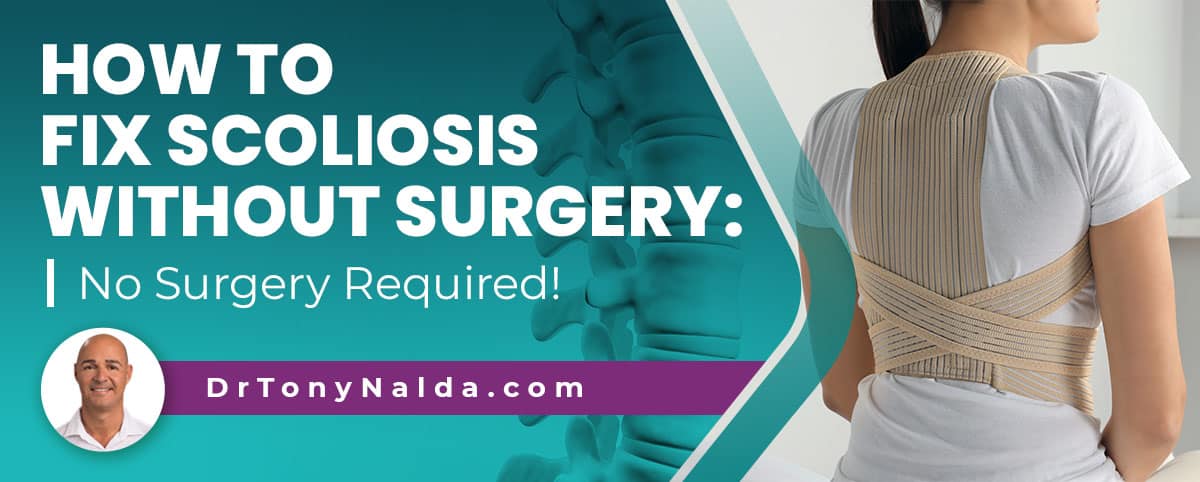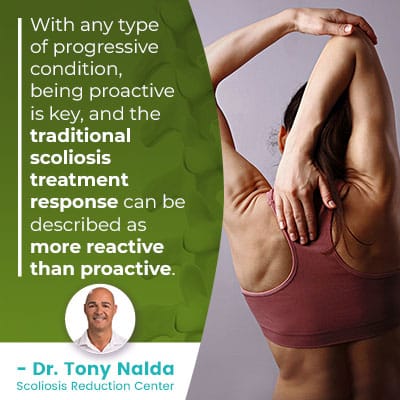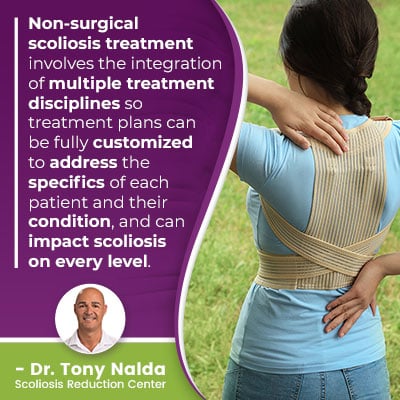How To Fix Scoliosis Without Surgery: No Surgery Required!

There are different approaches to scoliosis treatment, with each offering patients a different potential outcome. While spinal fusion surgery can straighten a crooked spine, the way it’s achieved can come at the expense of the spine’s overall health and function.
The reality is that most cases of scoliosis can be treated non-surgically, particularly when caught early and responded to with proactive treatment. A modern conservative chiropractic-centered treatment approach can impact scoliosis on every level for true corrective results.
Let’s address how to fix scoliosis without surgery by first explaining what’s happening inside the body of someone diagnosed with scoliosis.
Table of Contents
Receiving a Scoliosis Diagnosis
Being diagnosed with scoliosis means an unnatural sideways spinal curve has developed, with rotation.
The rotational component means the spine doesn’t just bend unnaturally to the side, but also twists, and this characteristic makes scoliosis a 3-dimensional condition.
In addition, the unnatural curve has to be of a minimum size to fulfill the parameters of a scoliosis diagnosis: Cobb angle measurement of 10+ degrees.
A patient’s Cobb angle is determined during X-ray and tells me how far out of alignment a scoliotic spine is, in addition to classifying conditions based on severity:
Mild scoliosis: Cobb angle measurement of between 10 and 25 degrees
Moderate scoliosis: Cobb angle measurement of between 25 and 40 degrees
Severe scoliosis: Cobb angle measurement of 40+ degrees
Very-severe scoliosis: Cobb angle measurement of 80+ degrees
So as you can see, scoliosis ranges widely in severity, and condition severity is an important classification point that shapes the crafting of effective treatment plans.
In addition, scoliosis isn’t a static condition, meaning where it is at the time of diagnosis is not indicative of where it will stay; as a progressive condition, scoliosis has it in its nature to worsen over time, particularly if left untreated, or not treated proactively.
Once a person receives a diagnosis of scoliosis, the most important decision is how to treat it moving forward, and there are two main scoliosis treatment approaches to choose between: traditional surgical treatment or modern non-surgical conservative treatment.
Traditional Surgical Scoliosis Treatment
 With any type of progressive condition, being proactive is key, and the traditional scoliosis treatment response can be described as more reactive than proactive.
With any type of progressive condition, being proactive is key, and the traditional scoliosis treatment response can be described as more reactive than proactive.
The reality is that traditional treatment doesn’t have a strategy for treating scoliosis while mild, so if an adolescent with mild scoliosis is on the path of traditional treatment, they’re often told to watch and wait; this involves returning at periodic intervals for reassessment on whether or not progression is occurring.
The problem I have with this is that, as a progressive condition, we know that virtually every case of scoliosis is going to progress at some point, so merely observing is wasting valuable treatment time.
In addition, in the condition’s most-prevalent form, adolescent idiopathic scoliosis (AIS), diagnosed between the ages of 10 and 18, growth and development is the condition’s main trigger for progression.
As adolescents are in, or are entering into, the stage of puberty characterized by rapid and unpredictable growth spurts, it’s likely that between assessments, growth can trigger significant progression, making the condition more challenging to treat.
Traditional treatment can apply bracing as a form of treatment, but traditional braces like the Boston brace are associated with a number of shortfalls, mainly related to how the brace squeezes the spine unnaturally, weakening it over time, and not acknowledging the condition’s rotational component (3-dimensional nature).
If a patient crosses the surgical-level threshold at 40+ degrees, becoming severe, and shows continued signs of progression, this is when traditional treatment tends to funnel patients towards spinal fusion surgery.
Spinal fusion surgery is a costly, lengthy, and invasive procedure that often results in a significant loss in spinal flexibility and range of motion; fortunately, there is another non-surgical approach to scoliosis treatment that strives to preserve as much of the spine’s natural function as possible.
Conservative Non-Surgical Scoliosis Treatment
Here at the Scoliosis Reduction Center, patients are treated with a modern conservative non-surgical approach, also known as chiropractic-centered and/or functional treatment.
I believe in the merits of proactive treatment so progression can be prevented and patients can be spared the hardships associated with increasing condition severity, escalating symptoms, and the need for invasive and risky surgical treatment in the future.
So can scoliosis be fixed without surgery? While every case is unique and there are no treatment guarantees, particularly if caught early and approached proactively, there are fewer limits to what we can achieve.
 Non-surgical scoliosis treatment involves the integration of multiple treatment disciplines so treatment plans can be fully customized to address the specifics of each patient and their condition, and can impact scoliosis on every level.
Non-surgical scoliosis treatment involves the integration of multiple treatment disciplines so treatment plans can be fully customized to address the specifics of each patient and their condition, and can impact scoliosis on every level.
I combine condition-specific chiropractic care, in-office therapy, corrective bracing, and custom-prescribed home exercises.
Chiropractic Care
There is an important distinction to be made between general chiropractic and scoliosis-specific chiropractic.
The complexities of scoliosis are beyond the scope of general chiropractic care, but a scoliosis chiropractor who knows both the spine, and how scoliosis affects it, can work towards impacting the condition on a structural level.
As a progressive structural condition, scoliosis has to, first and foremost, be impacted on a structural level.
Through a variety of chiropractic techniques and manual adjustments, I can work towards addressing any areas of spinal subluxation by repositioning the most-tilted vertebrae of the curve back into alignment with the rest of the spine.
As the spine becomes more aligned, its natural curves are being restored, and this improves the spine’s overall biomechanics, health, and function.
In-Office Therapy
As it’s not just the spine that’s in charge of maintaining its natural curves and alignment, but also its surrounding muscles, this is where the power of physical therapy and a variety of scoliosis-specific exercises (SSEs) can help.
Through the application of a variety of SSEs, core strength can be increased so the spine is optimally supported, and as muscle pain and imbalance can be a symptom of scoliosis, applying specific exercises can help keep the muscles as strong and loose as possible, while counteracting muscle imbalance.
In addition, certain SSEs are known to activate specific areas of the brain for improved brain-body communication, postural remodeling, and a more-natural body positioning.
While no exercise on its own can correct scoliosis on a structural level, when combined with other forms of proactive treatment, scoliosis-specific exercises can help augment corrective results.
Corrective Bracing
As mentioned, there are a number of shortfalls associated with traditional bracing, and modern corrective bracing addresses many of those shortfalls by representing the culmination of what we’ve learned about scoliosis, and bracing efficacy, over the years.
The ultra-corrective ScoliBrace is my top choice for meeting my patients’ bracing needs, and this is because it’s customized to suit a patient’s body and curvature type, and works by pushing the spine into a corrective position, rather than squeezing it unnaturally.
The design of the ScoliBrace addresses the condition’s 3-dimensional nature by working to improve both the unnatural sideways bend and the spine’s rotational component.
Custom-Prescribed Home Exercises
As a progressive condition, scoliosis is incurable; however, it is highly treatable.
If after the most intense phase of treatment is complete, a curvature reduction has been achieved, and core strength has been improved, the next stage is rehabilitation.
Through a series of custom-prescribed exercises, patients can establish a home-rehabilitation program for sustainable long-term results and to further stabilize the spine.
While critics of the conservative approach often see the need for continued maintenance as a downside of non-surgical treatment, I liken it to adolescents having to wear a retainer after having braces removed from their teeth; because the positioning of the teeth has been altered on a structural level, a retainer is needed to sustain those structural results.
The same can be said of the spine. Its unnatural curve has been reduced, but as scoliosis is incurable, the spine’s unnatural curve can return; however, the condition can be managed effectively with some regular home exercises and periodic visits to a scoliosis chiropractor.
Conclusion
When it comes to how to fix scoliosis without surgery, the answer is proactive conservative treatment that combines multiple treatment modalities for the best potential results.
Here at the Center, my patients can access multiple forms of effective treatment under one roof, and the benefits that each offers.
When condition-specific disciplines are integrated into a customized treatment plan, I can impact conditions, first and foremost, on a structural level, followed by applying a variety of therapies, corrective bracing, and rehabilitation to increase core strength address muscle weakness/imbalance, push the spine into a corrective position, and hold corrective results into the future.
Regardless of severity, the best time to start proactive scoliosis treatment is always now, so please don’t hesitate to reach out for guidance on the process of how to fix scoliosis without surgery.
Dr. Tony Nalda
DOCTOR OF CHIROPRACTIC
After receiving an undergraduate degree in psychology and his Doctorate of Chiropractic from Life University, Dr. Nalda settled in Celebration, Florida and proceeded to build one of Central Florida’s most successful chiropractic clinics.
His experience with patients suffering from scoliosis, and the confusion and frustration they faced, led him to seek a specialty in scoliosis care. In 2006 he completed his Intensive Care Certification from CLEAR Institute, a leading scoliosis educational and certification center.
About Dr. Tony Nalda
 Ready to explore scoliosis treatment? Contact Us Now
Ready to explore scoliosis treatment? Contact Us Now





